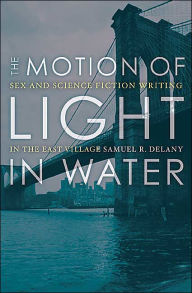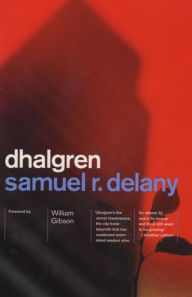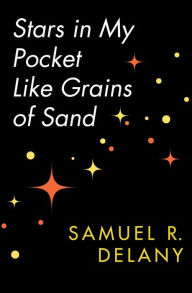Samuel Delany, Science Fiction and Cultural Pioneer, Turns 75

Samuel R. Delany turned 75 on April 1. “Chip” to his friends (what I wouldn’t give to be part of that group!), Delany is one of the Science Fiction Writers of America Grandmasters. He has won four Nebula Awards and two Hugos (with 15 other nominations between the two awards). But he is much more than just a great sci-fi author. He has been a literary critic, editor, essayist, and professor. He has been recognized for his work on LGBT issues with the Lambda Literary Award (twice), a Stonewall Honor Book award, and the Brudner Prize at Yale University.
Debug Notice: No product response from API
Delany grew up in Harlem, back when it was the epicenter of black culture in America. He has described having had one set of friends on the streets of Harlem, and a completely different set of friends at Dalton, the private, primarily white school he attended on New York City’s Upper East Side. He went on to the Bronx High School of Science, then to City College of New York. But he dropped out of college after only one semester to write (at age 19) his first novel, The Jewels of Aptor (recently reissued with two other early Delany novels under the title A B C: Three Short Novels). He also married the poet Marilyn Hacker in 1961. Between 1962 and 1968, he published a total of nine sci-fi novels and a number of short works, including his four Nebula Award winners, Babel-17, The Einstein Intersection, “Aye, and Gomorrah”, and “Time Considered as a Helix of Semi-Precious Stones” (which also won the Hugo Award, and is one of my favorite SF story titles of all time).
Delany grew up in Harlem, back when it was the epicenter of black culture in America. He has described having had one set of friends on the streets of Harlem, and a completely different set of friends at Dalton, the private, primarily white school he attended on New York City’s Upper East Side. He went on to the Bronx High School of Science, then to City College of New York. But he dropped out of college after only one semester to write (at age 19) his first novel, The Jewels of Aptor (recently reissued with two other early Delany novels under the title A B C: Three Short Novels). He also married the poet Marilyn Hacker in 1961. Between 1962 and 1968, he published a total of nine sci-fi novels and a number of short works, including his four Nebula Award winners, Babel-17, The Einstein Intersection, “Aye, and Gomorrah”, and “Time Considered as a Helix of Semi-Precious Stones” (which also won the Hugo Award, and is one of my favorite SF story titles of all time).
Debug Notice: No product response from API
The novels Delany wrote during this period were short, but invariably very deep. On the surface, Babel-17 is a tale of interstellar war, but it is really about the power of language. Spaceship captain, poet, linguist, and telepath Rydra Wong is recruited by her government to decipher what they believe is the enemy’s code, known as Babel-17. Wong discovers that it is actually a language, and that learning Babel-7 fundamentally changes the way you think (it’s a notion that resonated in the genre, anchoring the Ted Chiang short story that formed the basis of the recent film Arrival).
One clue to the complexity of The Einstein Intersection is that it starts with an epigraph from James Joyce’s Finnegan’s Wake. That Neil Gaiman wrote the foreword for the latest edition is more evidence that it is not your typical SF novel. In it, aliens live on a future Earth long abandoned by humans; they are trying to assimilate what they find of human culture, including our mythology. In this reimagining of Orpheus’ quest to find his lost love, Delany explores the power of mythology, and how those who are “different” define themselves against another culture.
The novels Delany wrote during this period were short, but invariably very deep. On the surface, Babel-17 is a tale of interstellar war, but it is really about the power of language. Spaceship captain, poet, linguist, and telepath Rydra Wong is recruited by her government to decipher what they believe is the enemy’s code, known as Babel-17. Wong discovers that it is actually a language, and that learning Babel-7 fundamentally changes the way you think (it’s a notion that resonated in the genre, anchoring the Ted Chiang short story that formed the basis of the recent film Arrival).
One clue to the complexity of The Einstein Intersection is that it starts with an epigraph from James Joyce’s Finnegan’s Wake. That Neil Gaiman wrote the foreword for the latest edition is more evidence that it is not your typical SF novel. In it, aliens live on a future Earth long abandoned by humans; they are trying to assimilate what they find of human culture, including our mythology. In this reimagining of Orpheus’ quest to find his lost love, Delany explores the power of mythology, and how those who are “different” define themselves against another culture.
The Motion of Light in Water: Sex and Science Fiction Writing in the East Village
The Motion of Light in Water: Sex and Science Fiction Writing in the East Village
Paperback $19.95
Between 1968 and 1975 Delany only published a few short works and a minor erotic novel. In his memoir The Motion of Light in Water (which won a Hugo Award in 1989 for Best Related Work) he describes himself during this period:
“I was a young black man, light-skinned enough so that four out of five people who met me, of whatever race, assumed I was white … I was a homosexual who now knew he could function heterosexually. And I was a young writer whose early attempts had already gotten him a handful of prizes … So, I thought, you are neither black nor white. You are neither male nor female. And you are that most ambiguous of citizens, the writer.”
In 1975, Delany published Dhalgren, his best known, and best-selling novel (the story of its publication, as told by its editor, the legendary Frederick Phol, is a saga all its own). Considering the complexity of his short works, it is no surprise that this doorstopper (800-plus pages) is challenging, to say the least.
Between 1968 and 1975 Delany only published a few short works and a minor erotic novel. In his memoir The Motion of Light in Water (which won a Hugo Award in 1989 for Best Related Work) he describes himself during this period:
“I was a young black man, light-skinned enough so that four out of five people who met me, of whatever race, assumed I was white … I was a homosexual who now knew he could function heterosexually. And I was a young writer whose early attempts had already gotten him a handful of prizes … So, I thought, you are neither black nor white. You are neither male nor female. And you are that most ambiguous of citizens, the writer.”
In 1975, Delany published Dhalgren, his best known, and best-selling novel (the story of its publication, as told by its editor, the legendary Frederick Phol, is a saga all its own). Considering the complexity of his short works, it is no surprise that this doorstopper (800-plus pages) is challenging, to say the least.
Dhalgren
Dhalgren
By
Samuel R. Delany
Foreword by
William Gibson
Paperback $20.00
It explores themes of race, sex, identity, and art as it ostensibly tells the story of a trip to and through Bellona, a fictional city in the center of the country, cut off from the rest of the world by some mysterious catastrophe. You can only enter or leave the city on foot, and by a single bridge. The protagonist is a man with partial amnesia, unable to remember his name or his parents, only that his mother was Native American. He does remember a stay in a mental hospital, so his reliability as a narrator is in question. And he sees many strange things in Bellona: street signs change, landmarks move. Gangs roam the city, hiding in huge holographic projections of insects and mythological beasts. There is frequent violence, and explicit sex in many variations. One night, the clouds part, revealing two moons in the sky. On another day, a huge swollen red sun rises, only to retreat back across the sky to set on the same horizon.
William Gibson has called Dhalgren of one of his favorites. But in the foreword he wrote for the latest edition, he admits, “I have never understood it. I have sometimes felt that I partially understood it, or that I was nearing the verge of understanding it… Dhalgren is not there to be finally understood. I believe its ‘riddle’ was never meant to be ‘solved’.” Delany does not dispute this. He has said the book offers a variety of answers, and you have to negotiate your way through it to decide which answer is the most interesting one for you. I personally read it many years ago. (I am old enough to have read Delany’s novels soon after they were published.) I felt much the same as Gibson, but I may not have gotten as close to understanding it as he did.
It explores themes of race, sex, identity, and art as it ostensibly tells the story of a trip to and through Bellona, a fictional city in the center of the country, cut off from the rest of the world by some mysterious catastrophe. You can only enter or leave the city on foot, and by a single bridge. The protagonist is a man with partial amnesia, unable to remember his name or his parents, only that his mother was Native American. He does remember a stay in a mental hospital, so his reliability as a narrator is in question. And he sees many strange things in Bellona: street signs change, landmarks move. Gangs roam the city, hiding in huge holographic projections of insects and mythological beasts. There is frequent violence, and explicit sex in many variations. One night, the clouds part, revealing two moons in the sky. On another day, a huge swollen red sun rises, only to retreat back across the sky to set on the same horizon.
William Gibson has called Dhalgren of one of his favorites. But in the foreword he wrote for the latest edition, he admits, “I have never understood it. I have sometimes felt that I partially understood it, or that I was nearing the verge of understanding it… Dhalgren is not there to be finally understood. I believe its ‘riddle’ was never meant to be ‘solved’.” Delany does not dispute this. He has said the book offers a variety of answers, and you have to negotiate your way through it to decide which answer is the most interesting one for you. I personally read it many years ago. (I am old enough to have read Delany’s novels soon after they were published.) I felt much the same as Gibson, but I may not have gotten as close to understanding it as he did.
Stars in My Pocket Like Grains of Sand
Stars in My Pocket Like Grains of Sand
In Stock Online
eBook
$10.49
$11.99
After Dhalgren, Delany wrote two more major SF novels, Trouble on Triton and Stars in My Pocket Like Grains of Sand. For the most part, the rest of his career has been devoted to fantasy (the Return to Nevèrÿon stories), literary criticism, and autobiographic works.
Clearly, Delany was a harbinger of the diversity that we are enjoying in science fiction and fantasy now. Not surprisingly, he was asked, in a 2015 New Yorker article, about the Sad Puppies/Hugo Awards backlash against that supposed push for “diversity” as a way to win brownie points. He responded that he was dismayed, but not surprised. “The context changes,” he said. “The rhetoric remains the same”
But he struck a more hopeful note in another interview, this one in The Paris Review in 2011. He was asked about a question that Octavia Butler tried to answer in her essay “Positive Obsession”—what good is science fiction, especially to black people? Delany responded, “Science fiction isn’t just thinking about the world out there. It’s also thinking about how that world might be—a particularly important exercise for those who are oppressed, because if they’re going to change the world we live in, they—and all of us—have to be able to think about a world that works differently.”
That is one of the reasons I value science fiction. And there is a message there for “all of us” that is as important today as it ever was.
Explore the work of Samuel R. Delany.
After Dhalgren, Delany wrote two more major SF novels, Trouble on Triton and Stars in My Pocket Like Grains of Sand. For the most part, the rest of his career has been devoted to fantasy (the Return to Nevèrÿon stories), literary criticism, and autobiographic works.
Clearly, Delany was a harbinger of the diversity that we are enjoying in science fiction and fantasy now. Not surprisingly, he was asked, in a 2015 New Yorker article, about the Sad Puppies/Hugo Awards backlash against that supposed push for “diversity” as a way to win brownie points. He responded that he was dismayed, but not surprised. “The context changes,” he said. “The rhetoric remains the same”
But he struck a more hopeful note in another interview, this one in The Paris Review in 2011. He was asked about a question that Octavia Butler tried to answer in her essay “Positive Obsession”—what good is science fiction, especially to black people? Delany responded, “Science fiction isn’t just thinking about the world out there. It’s also thinking about how that world might be—a particularly important exercise for those who are oppressed, because if they’re going to change the world we live in, they—and all of us—have to be able to think about a world that works differently.”
That is one of the reasons I value science fiction. And there is a message there for “all of us” that is as important today as it ever was.
Explore the work of Samuel R. Delany.


